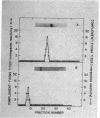Abstract
Mammalian type-C viruses contain a major internal polypeptide of about 30,000 daltons that is characterized by both intraspecies and interspecies antigenic reactivities. Radioimmunoprecipitation assays were used for measurement of this protein; the assay was based upon interspecies reactivities of the protein. As little as 5 ng of the group-specific antigen of murine leukemia virus can be measured by radioimmunoprecipitation assays, thus providing an approximate 10,000-fold increase in sensitivity over the standard immunodiffusion procedure. The type-C viruses that were recently isolated from a woolly monkey and gibbon ape each have an interspecies type-C antigenic reactivity. The primate viruses, however, could be distinguished from the type-C viruses of murine, rat, hamster, and feline origin that were more highly related to each other. The interspecies reactivity of the 30,000-dalton polypeptide is an immunological marker of the mammalian type-C viruses, since even with this sensitive assay other mammalian viruses with RNA-dependent DNA polymerase activity did not contain the type-C interspecies antigen.
Keywords: gs-3, visna, Mason-Pfizer virus, syncytium-forming virus
Full text
PDF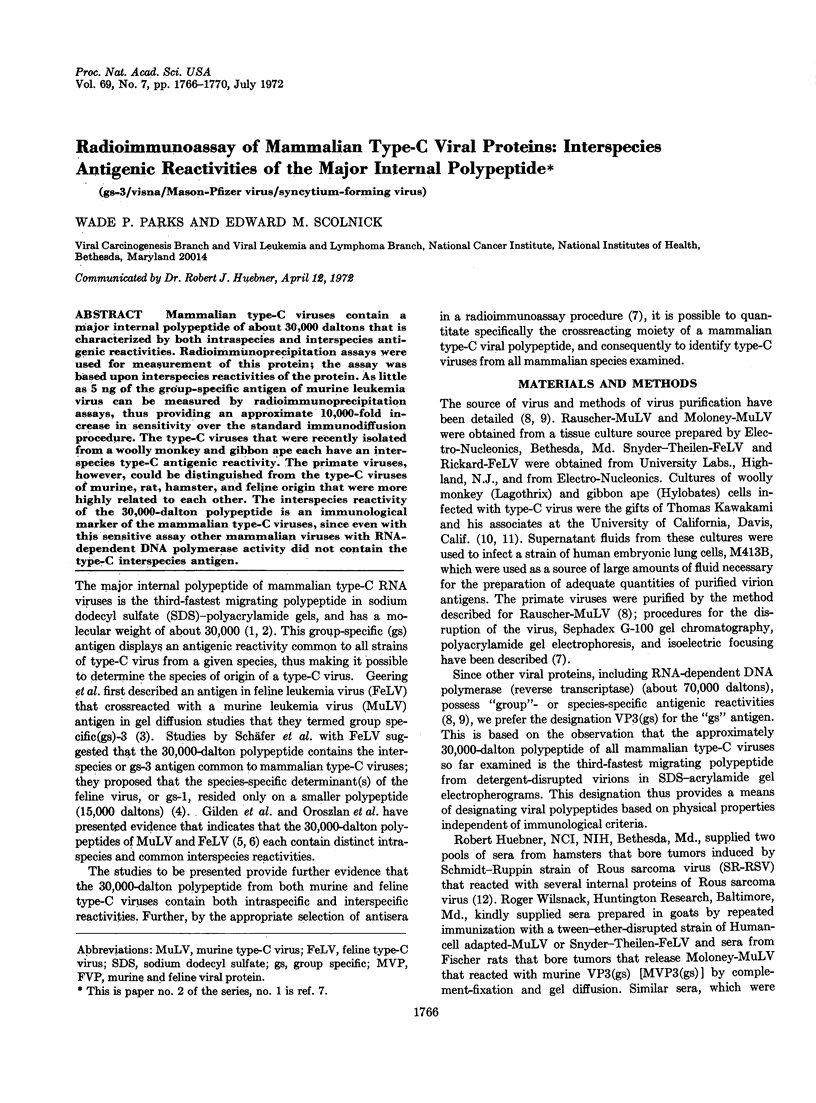
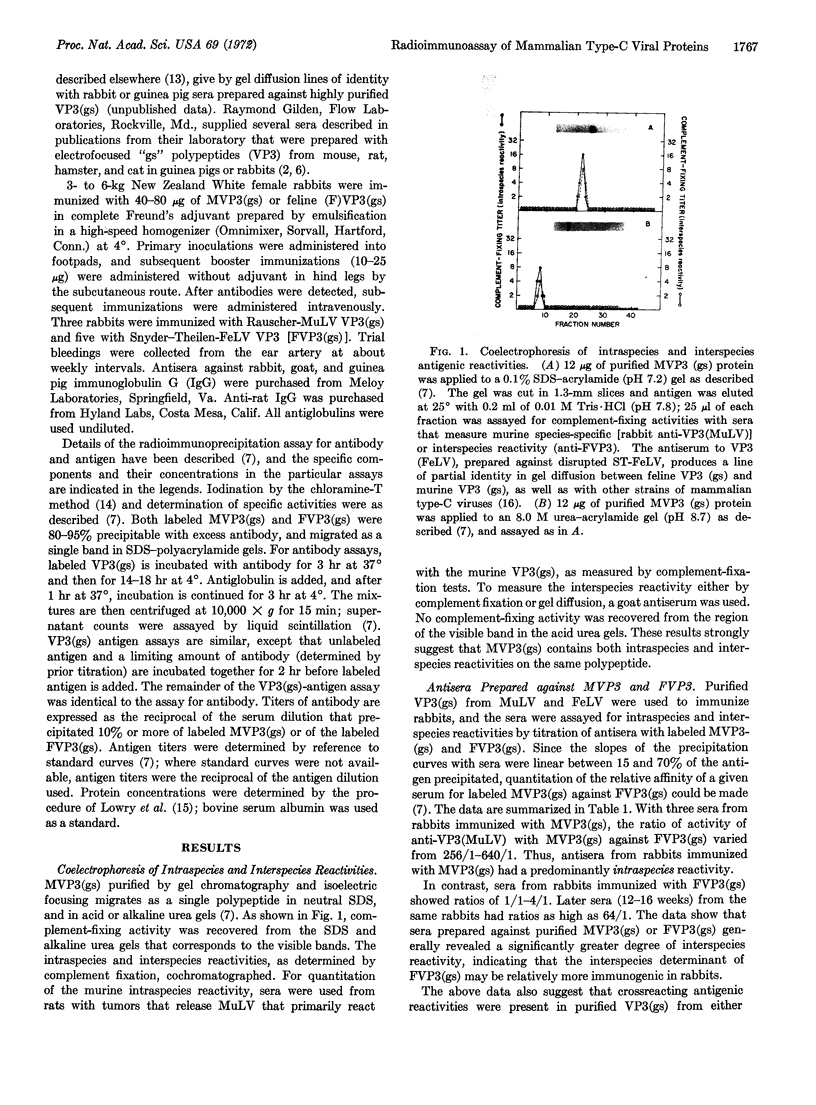
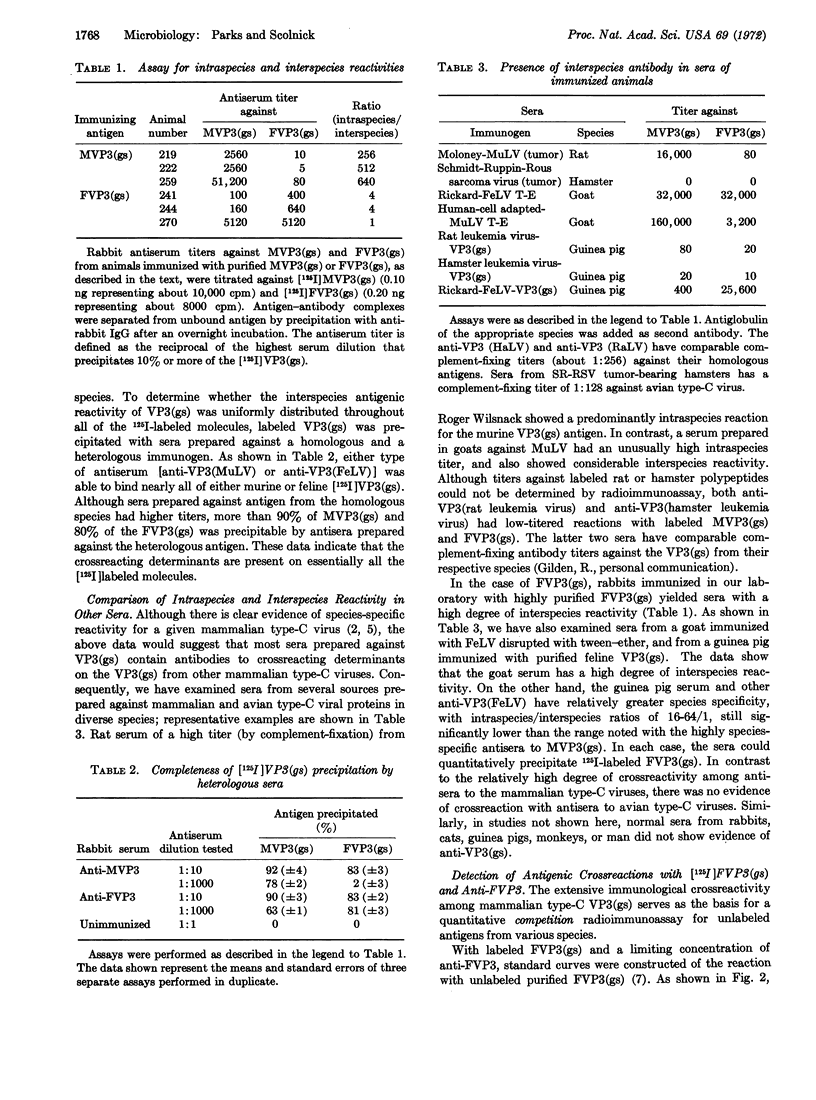
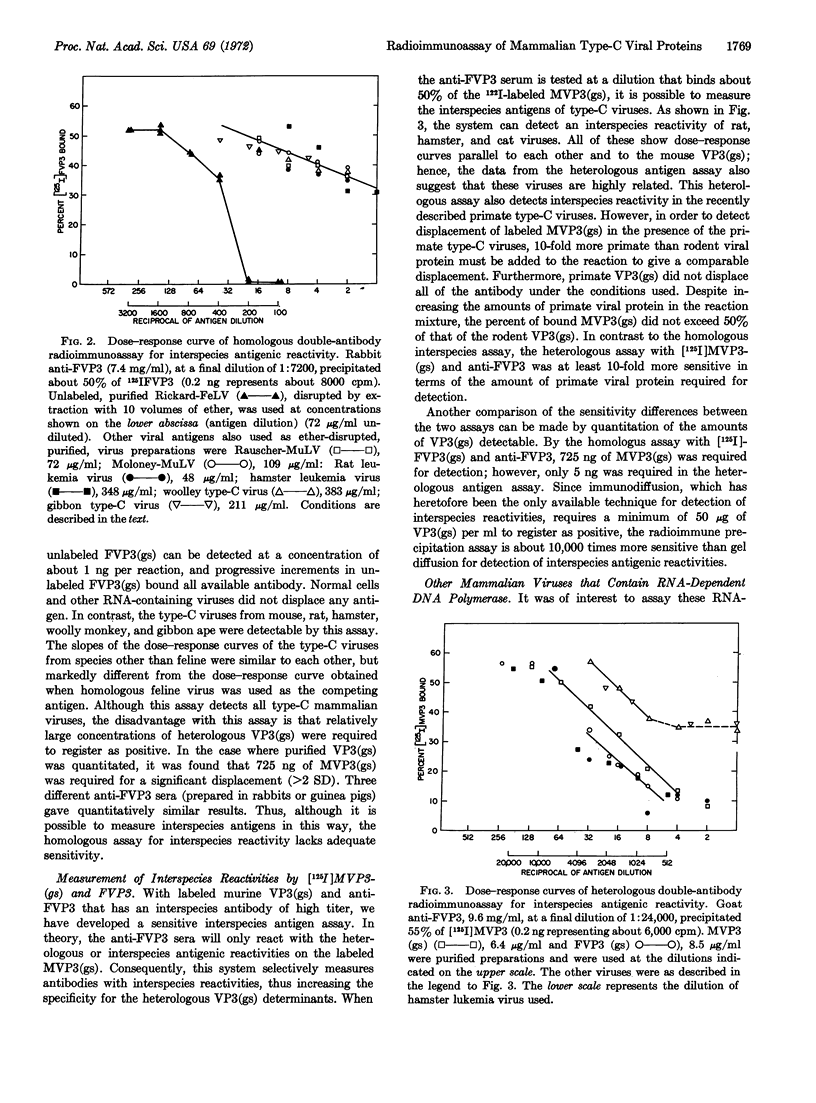
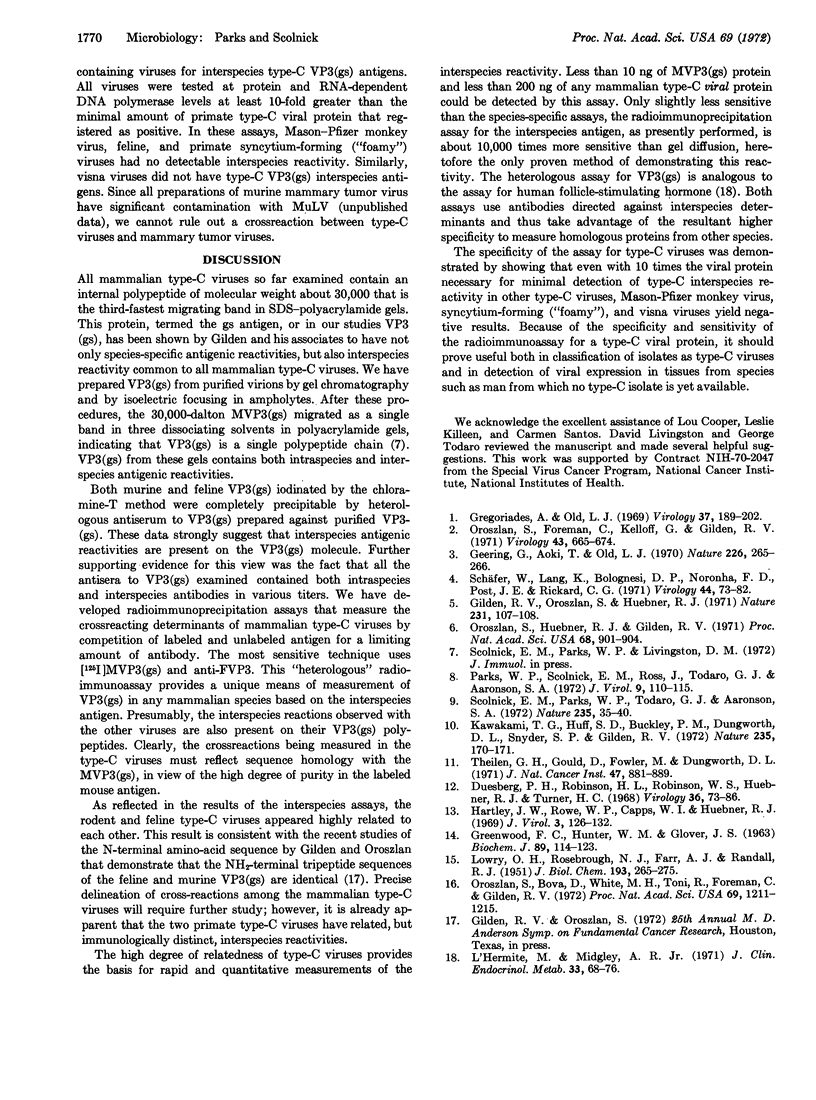
Images in this article
Selected References
These references are in PubMed. This may not be the complete list of references from this article.
- Duesberg P. H., Robinson H. L., Robinson W. S., Huebner R. J., Turner H. C. Proteins of Rous sarcoma virus. Virology. 1968 Sep;36(1):73–86. doi: 10.1016/0042-6822(68)90118-9. [DOI] [PubMed] [Google Scholar]
- GREENWOOD F. C., HUNTER W. M., GLOVER J. S. THE PREPARATION OF I-131-LABELLED HUMAN GROWTH HORMONE OF HIGH SPECIFIC RADIOACTIVITY. Biochem J. 1963 Oct;89:114–123. doi: 10.1042/bj0890114. [DOI] [PMC free article] [PubMed] [Google Scholar]
- Geering G., Aoki T., Old L. J. Shared viral antigen of mammalian leukaemia viruses. Nature. 1970 Apr 18;226(5242):265–266. doi: 10.1038/226265a0. [DOI] [PubMed] [Google Scholar]
- Gilden R. V., Oroszlan S., Huebner R. J. Coexistence of intraspecies and interspecies specific antigenic determinants on the major structural polypeptide of mammalian C-type viruses. Nat New Biol. 1971 May 26;231(21):107–108. doi: 10.1038/newbio231107a0. [DOI] [PubMed] [Google Scholar]
- Gregoriades A., Old L. J. Isolation and some characteristics of a group-specific antigen of the murine leukemia viruses. Virology. 1969 Feb;37(2):189–202. doi: 10.1016/0042-6822(69)90198-6. [DOI] [PubMed] [Google Scholar]
- Hartley J. W., Rowe W. P., Capps W. I., Huebner R. J. Isolation of naturally occurring viruses of the murine leukemia virus group in tissue culture. J Virol. 1969 Feb;3(2):126–132. doi: 10.1128/jvi.3.2.126-132.1969. [DOI] [PMC free article] [PubMed] [Google Scholar]
- Kawakami T. G., Huff S. D., Buckley P. M., Dungworth D. L., Synder S. P., Gilden R. V. C-type virus associated with gibbon lymphosarcoma. Nat New Biol. 1972 Feb 9;235(58):170–171. doi: 10.1038/newbio235170a0. [DOI] [PubMed] [Google Scholar]
- L'Hermite M., Midgley A. R., Jr Radioimmunoassay of human follicle-stimulating hormone with antisera to the ovine hormone. J Clin Endocrinol Metab. 1971 Jul;33(1):68–76. doi: 10.1210/jcem-33-1-68. [DOI] [PubMed] [Google Scholar]
- LOWRY O. H., ROSEBROUGH N. J., FARR A. L., RANDALL R. J. Protein measurement with the Folin phenol reagent. J Biol Chem. 1951 Nov;193(1):265–275. [PubMed] [Google Scholar]
- Oroszlan S., Bova D., Martin White M. H., Toni R., Foreman C., Gilden R. V. Purification and immunological characterization of the major internal protein of the RD-114 virus. Proc Natl Acad Sci U S A. 1972 May;69(5):1211–1215. doi: 10.1073/pnas.69.5.1211. [DOI] [PMC free article] [PubMed] [Google Scholar]
- Oroszlan S., Foreman C., Kelloff G., Gilden R. V. The group-specific antigen and other structural proteins of hamster and mouse C-type viruses. Virology. 1971 Mar;43(3):665–674. doi: 10.1016/0042-6822(71)90290-x. [DOI] [PubMed] [Google Scholar]
- Oroszlan S., Huebner R. J., Gilden R. V. Species-specific and interspecific antigenic determinants associated with the structural protein of feline C-type virus. Proc Natl Acad Sci U S A. 1971 May;68(5):901–904. doi: 10.1073/pnas.68.5.901. [DOI] [PMC free article] [PubMed] [Google Scholar]
- Parks W. P., Scolnick E. M., Ross J., Todaro G. J., Aaronson S. A. Immunological relationships of reverse transcriptases from ribonucleic acid tumor viruses. J Virol. 1972 Jan;9(1):110–115. doi: 10.1128/jvi.9.1.110-115.1972. [DOI] [PMC free article] [PubMed] [Google Scholar]
- Schäfer W., Lange J., Bolognesi D. P., De Noronha F., Post J. E., Rickard C. G. Isolation and characterization of two group-specific antigens from feline leukemia virus. Virology. 1971 Apr;44(1):73–82. doi: 10.1016/0042-6822(71)90154-1. [DOI] [PubMed] [Google Scholar]
- Scolnick E. M., Parks W. P., Todaro G. J., Aaronson S. A. Immunological characterization of primate C-type virus reverse transcriptases. Nat New Biol. 1972 Jan 12;235(54):35–40. doi: 10.1038/newbio235035a0. [DOI] [PubMed] [Google Scholar]
- Theilen G. H., Gould D., Fowler M., Dungworth D. L. C-type virus in tumor tissue of a woolly monkey (Lagothrix spp.) with fibrosarcoma. J Natl Cancer Inst. 1971 Oct;47(4):881–889. [PubMed] [Google Scholar]



